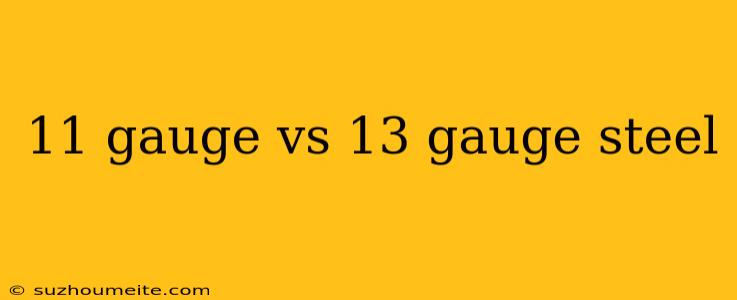11 Gauge vs 13 Gauge Steel: Understanding the Difference
When it comes to steel gauge, there are various options available, each with its unique characteristics and uses. Two of the most common steel gauges are 11 gauge and 13 gauge. While they may seem similar, they have distinct differences in terms of thickness, strength, and application. In this article, we'll delve into the differences between 11 gauge and 13 gauge steel to help you make an informed decision for your project.
What is Steel Gauge?
Before we dive into the comparison, let's first understand what steel gauge is. Steel gauge refers to the thickness of a steel sheet or plate. The gauge system is based on the American Wire Gauge (AWG) system, which defines the diameter of a wire. In the context of steel, the gauge number is inversely proportional to the thickness of the steel. The lower the gauge number, the thicker the steel.
11 Gauge Steel
Thickness
11 gauge steel has a thickness of 0.120 inches (3.05 mm). This thickness makes it a popular choice for applications that require a balance between strength and flexibility.
Strength
11 gauge steel has a minimum yield strength of 33,000 pounds per square inch (psi) and a minimum tensile strength of 45,000 psi. This makes it suitable for structures that need to withstand moderate loads and stress.
Applications
11 gauge steel is commonly used in:
- Building frames: 11 gauge steel is often used in building frames due to its strength, durability, and resistance to corrosion.
- Equipment manufacturing: This gauge is used in the manufacture of equipment, such as machinery and tools.
- Automotive industry: 11 gauge steel is used in the production of automotive parts, such as body panels and chassis components.
13 Gauge Steel
Thickness
13 gauge steel has a thickness of 0.090 inches (2.29 mm). This gauge is thinner than 11 gauge, making it more suitable for applications that require a lower weight and higher formability.
Strength
13 gauge steel has a minimum yield strength of 26,000 psi and a minimum tensile strength of 38,000 psi. While it's not as strong as 11 gauge, it's still suitable for applications that don't require extreme strength.
Applications
13 gauge steel is commonly used in:
- Furniture making: 13 gauge steel is often used in furniture making due to its ease of formability and lower weight.
- Appliances: This gauge is used in the production of appliance components, such as refrigerator shelves and dishwasher racks.
- HVAC industry: 13 gauge steel is used in the manufacture of heating, ventilation, and air conditioning (HVAC) components.
Comparison of 11 Gauge and 13 Gauge Steel
| Characteristic | 11 Gauge | 13 Gauge |
|---|---|---|
| Thickness | 0.120 inches (3.05 mm) | 0.090 inches (2.29 mm) |
| Minimum Yield Strength | 33,000 psi | 26,000 psi |
| Minimum Tensile Strength | 45,000 psi | 38,000 psi |
| Applications | Building frames, equipment manufacturing, automotive industry | Furniture making, appliances, HVAC industry |
Conclusion
In conclusion, 11 gauge and 13 gauge steel have distinct differences in terms of thickness, strength, and application. 11 gauge steel is thicker, stronger, and more suitable for applications that require high strength and durability. 13 gauge steel, on the other hand, is thinner, lighter, and more formable, making it ideal for applications that require ease of fabrication and lower weight.
When choosing between 11 gauge and 13 gauge steel, consider the specific requirements of your project, including the level of strength, durability, and formability needed. By understanding the differences between these two gauges, you can make an informed decision and select the right steel for your application.
